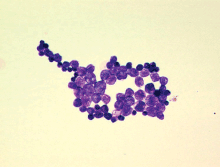|
Prototheca
Prototheca is a genus of algae in the family Chlorellaceae.[3] While this genus is a member of the green algae, all Prototheca no longer have chloroplasts and therefore their photosynthetic ability. Some species can cause protothecosis in humans and various vertebrates. EtymologyFrom the Greek proto- (first) + thēkē (sheath), Prototheca is a genus of variably shaped spherical cells of achloric algae in the family Chlorellaceae. Wilhelm Krüger, a German expert in plant physiology and sugar production, reported Prototheca microorganisms in 1894, shortly after spending 7 years in Java studying sugarcane. He isolated Prototheca species from the sap of 3 tree species. Krüger named these organisms as P. moriformis and P. zopfii, the second name as a tribute to Friedrich Wilhelm Zopf, a renowned botanist, mycologist, and lichenologist.[4] Evolution and TaxonomyAlthough Prototheca lack chloroplasts, they were recognized early on as closely related to other Chlorellaceae based on other morphological and physiological traits similar to the group.[5][6] Phylogenetics confirm that Prototheca species are closely related to Chlorella and other genera, although it is not yet clear whether Prototheca is a monophyletic group.[7] BiologyWith the lack of chloroplasts and photosynthetic ability, Prototheca grow heterotrophically and some exhibit parasitism. Other groups of photosynthetic organisms have undergone similar functional losses in photosynthetic ability and shifted to a parasitic lifestyle, such as in apicomplexans. PathogenicitySome species in the genus Prototheca are known to cause protothecosis, one of the few researched diseases caused by algae, which are categorized as Algaemia. P. wickerhamii is the main causing agent of protothecosis in humans, and was first identified as such in 1964. P. zopfii is known to cause this disease in cattle and dogs.[citation needed] Symptoms include: Cutaneous lesions, Olecranon bursitis. References
|
||||||||||||||||||||||
